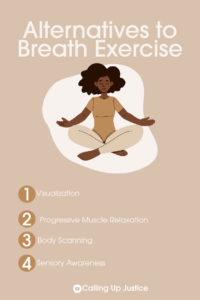For theater makers and social justice workers, starting meetings with a grounding or embodiment exercise can be a great way to connect a group and foster a sense of community. Breathing exercises, in particular, can be a powerful tool to promote relaxation, reduce stress, and increase focus. However, it’s important to recognize that not everyone can participate in these exercises in the same way. Some individuals may have difficulty with deep breathing, whether due to respiratory conditions or other physical limitations. For these individuals, it’s important to provide alternative ways to participate in group grounding exercises.
Breathing exercises are often used as a tool for relaxation and stress reduction. They work by activating the parasympathetic nervous system, which helps to counteract the fight-or-flight response triggered by stress. When we take deep breaths, we activate the diaphragm, which in turn stimulates the vagus nerve. This nerve sends signals to the brain to slow down the heart rate, decrease blood pressure, and promote feelings of relaxation and calmness.
While breathing exercises can be helpful for many people, they may not be accessible to everyone. Some individuals may have physical limitations that make it difficult or uncomfortable to take deep breaths. For example, individuals with asthma or other respiratory conditions may find it challenging to take deep breaths. Additionally, some people may have experienced trauma that makes deep breathing triggers for anxiety or panic.
There are alternative methods for grounding that do not rely on breathing exercises. For example, progressive muscle relaxation is a technique that involves tensing and releasing muscle groups to promote relaxation. This technique can be helpful for individuals who find breathing exercises challenging or triggering.
Another alternative to breathing exercises is visualization. Visualization involves imagining a calm and peaceful scene or scenario. This technique can be helpful for individuals who have difficulty with deep breathing or who find it difficult to focus on their breath. Guided imagery or meditation can be especially helpful for individuals who have experienced trauma and may be triggered by deep breathing exercises.
Other techniques that can be helpful for grounding include mindfulness exercises, body scanning, and sensory awareness. Mindfulness exercises involve paying attention to the present moment without judgment, while body scanning involves bringing awareness to different parts of the body. Sensory awareness involves focusing on the five senses and engaging with the present moment.
While breathing exercises can be a powerful tool for grounding and relaxation, they are not always accessible to everyone. Individuals with physical limitations or trauma may find breathing exercises challenging or triggering. Therefore, it is essential to explore alternative methods for grounding that do not rely on breathing exercises. Progressive muscle relaxation, visualization, mindfulness exercises, body scanning, and sensory awareness are all techniques that can be helpful for individuals who have difficulty with breathing exercises. By providing a variety of options, we can ensure that everyone in a group can participate in grounding exercises and feel supported in their wellness journey.

